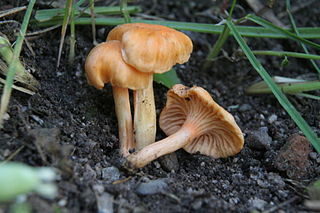
Cantharellus is a genus of popular edible mushrooms, commonly known as chanterelles, a name which can also refer to the type species, Cantharellus cibarius. They are mycorrhizal fungi, meaning they form symbiotic associations with plants, making them very difficult to cultivate. Caution must be used when identifying chanterelles for consumption due to lookalikes, such as the Jack-O-Lantern species, which can make a person very ill. Despite this, chanterelles are one of the most recognized and harvested groups of edible mushrooms.

Tulbaghia is a genus of monocotyledonous herbaceous perennial bulbs native to Africa, belonging to the Amaryllis family. It is one of only two known genera in the society garlic tribe within the onion subfamily. The genus was named for Ryk Tulbagh (1699–1771), one time governor of The Cape of Good Hope.

Potamogeton crispus, the curled pondweed or curly-leaf pondweed, is a species of aquatic plant native to Eurasia but an introduced species and often a noxious weed in North America.

The Caspian kutum or Caspian white fish is a member of the family Cyprinidae from brackish water habitats of the Caspian Sea and from its freshwater tributaries. It is typically a medium-sized fish, reaching 45–55 cm in length, rarely 70 cm, and weighing up to 4.00 kg, rarely 5.00 kg. It used to be very common and was harvested commercially. The population seems to have collapsed due to overfishing and marine pollution. Its flesh and roe are enjoyed as food, and highly prized in the Gilan and Mazandaran provinces in Iran.

Leersia is a genus of plants in the grass family which includes species known generally as cutgrasses.

Goneplax rhomboides is a species of crab. It is known by the common name angular crab because of its angular carapace. Although it is also called the square crab, its shell is in fact more trapezoidal than square. This species is also known as the mud-runner because they are able to run away quickly when threatened.
Callianassa subterranea is a species of burrowing ghost shrimp. This species is known by such generic common names as "mud shrimp" and "ghost shrimp".

Fries's goby is a species of goby native to the Eastern Atlantic Ocean along the coasts of Europe and northern Africa as well as the Mediterranean Sea to the Sea of Marmara. This species burrows into muddy or muddy sand substrates at depths of from 10 to 130 metres and is frequently found in association with the Norway lobster Nephrops norvegicus. This species can reach a length of 13 centimetres (5.1 in) TL. The specific name honours the Swedish zoologist Bengt Fredrik Fries (1799-1839).

Marvel's The Avengers, or simply The Avengers, is a 2012 American superhero film based on the Marvel Comics superhero team of the same name, produced by Marvel Studios and distributed by Walt Disney Studios Motion Pictures. It is the sixth film in the Marvel Cinematic Universe (MCU). The film was written and directed by Joss Whedon and features an ensemble cast that includes Robert Downey Jr., Chris Evans, Mark Ruffalo, Chris Hemsworth, Scarlett Johansson, and Jeremy Renner as the titular Avengers team, alongside Tom Hiddleston, Clark Gregg, Cobie Smulders, Stellan Skarsgård, and Samuel L. Jackson. In the film, Nick Fury, director of the spy agency S.H.I.E.L.D., recruits Tony Stark, Steve Rogers, Bruce Banner, and Thor to form a team that must stop Thor's brother Loki from subjugating Earth.
Hjortstamia is a genus of poroid fungi in the family Phanerochaetaceae. It was circumscribed by French mycologists Jacques Boidin and Gilles Liège in 2003. Miettinen and colleagues consider Hjortstamia to be a taxonomy of Phlebiopsis based on molecular phylogenetics.

Cucurbitaria is a genus of corticioid fungi in the family Cucurbitariaceae. The genus was circumscribed by Samuel Frederick Gray in 1821.

Potamogeton obtusifolius, known as blunt-leaved pondweed, is an aquatic plant in the genus Potamogeton. It grows mainly in mesotrophic to eutrophic lakes, ponds and ditches, rarely in brackish water. It occurs primarily in Central Europe, the British Isles, Fennoscandia and eastern North America.

Cantharellus friesii, the orange or velvet chanterelle, is a fungus native to Asia and Europe. The cap color varies from deep yellow to reddish orange and is 2–4 cm wide. It occurs in beech, fir and spruce forests. C. friesii is considered a good edible mushroom, but because of its rarity, it deserves protection. The specific epithet friesii honors the mycologist Elias Magnus Fries.
Ophioceras is a genus of fungi in the family Magnaporthaceae.

Lesueurigobius is a genus of gobies native to the eastern Atlantic Ocean. The generic name honours the French naturalist Charles Alexandre Lesueur (1778-1846), for whom the type species, Lesueurigobius suerii, was named, Georg Duncker's name Lesueuria being preoccupied by a genus of comb jellies.
Taeniolella is a genus of anamorphic fungi in the family Mytilinidiaceae. It was described in 1958 by Canadian mycologist Stanley John Hughes.

Potamogeton friesii, known as flat-stalked pondweed, or Fries' pondweed, is an aquatic plant in the genus Potamogeton. It grows mainly in mesotrophic to eutrophic rivers, lakes, ponds and ditches, rarely in brackish water. It occurs in North America, Europe, western Asia and a few scattered locations elsewhere in Asia.
Pilosella friesii – not to be confused with the European P. schultesii – is a North American plant species in the dandelion tribe within the sunflower family. It is widespread across much of Mexico with a few populations in Guatemala and western Texas.













